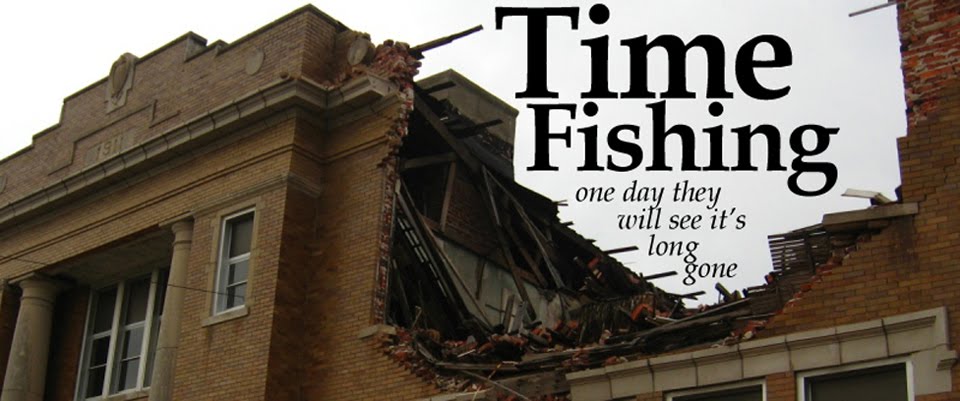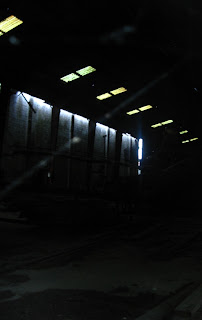
Readers may remember when
I mentioned all of the abandoned gas stations lining highway 367. Old gas stations are one of my favorite subjects, simply because they are positively
everywhere. They also tend to be cunningly hidden, which presents a fair challenge. Highway 367 is brimming with them if one knows where to look.

Our good friend the metal dinosaur (now painted green!) heralds the start of the gas station parade. Most old stations were quite small, featuring one or two garages, an office/supply shop, and usually no more than two pumps. As more and more people bought cars, and the larger gas companies started building convenient stores and restaurants into their stations, the smaller ones became outmoded. Many, however, remain viable businesses, but no longer retain their gasoline-selling identity and are devoid of pumps. In fact, the car dealership to which metal dino belongs is a former station.

The telltale sign is the concrete island to dino's left. This is the structure which originally would have housed the two pumps: note the overgrown hold just to the right of the pole. Upon closer inspection, the hole contains many tubes which once would have connected to a pump.
Here are a few more old stations seen between Searcy and Bald Knob (click to enlarge):






All of the above stations are either completely abandoned or are still being used as auto repair shops. Sometimes, though, they take on an entirely new identity.

This station, only identifiable by its 60's or 70's wavy canopy, seems to have become a lumber yard and is completely fenced off.

This one, one of my favorites for its gigantic triangular canopy (seriously, that thing looks deadly), now houses a pecan business. We found this antique scale sitting outside:

The birds living in a hole somewhere in the ceiling haven't treated the scale very well.

This station's canopy peeks over the owners' burgeoning fruit and vegetable stand. Ever wanted to buy fresh tomatoes at a gas station?

This one (possibly an old Sinclair station) has been granted the unlikely job of Bald Knob Fire Station. It's right next to the
Bald Knob Farmer's Market.

Sometimes it's pretty hard to know what these buildings used to be. I think the structure bulging from the right side of the building is added on and may cover what was once a garage. The only way I figured this one out is because of the distinctive curved filling station light post, seen on the far right of the frame. These particular light posts are present at an alarming number of gas stations, and some still linger in places where they have become meaningless. I still have yet to figure out the significance of these guys.
I love these old stations, but my favorite is one which I've mentioned before.

This is clearly the oldest station on the stretch, demonstrating its age with a highly individual architectural style including a decorative gable (closeup pictured at the top of the entry) and wooden garage doors. It's another one which is suffering from an identity crisis, having been transformed into a hair salon. But I'd rather have it house some business than none. It's listed on the
national register of historical places, along with the cafe next to it which was designed by the same architect. Here's a closeup of the beautiful wooden garage doors:

Given the sheer number of stations on 367, It's clear that the road was once a heavily traveled thoroughfare. Now, the stations are just relics of a time when drivers could see more than just trees and 100-foot-tall signposts from the road.

-Jonesy

































